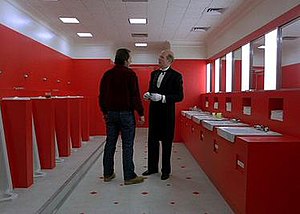For help on planning our shots, my group and I have been given the task of planning, shooting and editing a clip with the following criteria:
[Criteria]
In order to succeed in this task our group first decided to plan out the shots we would take- scripting and dialogue was less important in this task as that was not what we were being evaluated on. We chose to use a variety of shots to build suspense in our clip as that would prepare us for the final task of making a thriller.
- (MS) Character #1 (Aayush) slowly walking towards the camera whilst on the phone.
- (ECU) Of the phone displaying a text message received by character #2 (Ashley) telling (Aayush) to meet him in the cafe.
- (Tracking Shot) tracking (Aayush's) movements from his location to the cafe, then meets (Ashley).
- (Pan) round (Aayush) to reveal character #2 sitting down as character #1 takes a seat opposite character #2.
- (MS) cut-in = Character #1 sits down. He begins to talk to character#2
- (Over Shoulder Shot) shot over character #2's perspective as character#1 talks
- (MS) character #2 responds to the dialogue.
- (CU) character #1 expresses facial expression
- (CU) character #1 clenches fist
- (MS) camera placed behind character #1 as he swings his arm to punch character #2.
- Over shoulder shot of character #2 as he reacts to the punch.
In addition to planning the shots, we also had to storyboard them to complete our planning for this task:
For our final piece the storyboard will be much more developed with more detailed pictures and more annotations as the dialogue and transitions will be more complex. We will also used more advanced filming equipment and an actual set rather than only filming in school.
Once we were happy with our planning we collected the equipment, we took a tripod as well as a camera to ensure we got steady-shots where we wanted them. The rest of the filming was fairly straight forward, however we made a few continuity errors when filming as the props in some shots were not included in others due to lack of proportion. As a result we had to re-film some mistakes we had noticed in editing. However, this also gave us a chance to re-shoot some shots that we thought could be improved or changed to give a different effect on the audience. As our main focus was continuity, we decided to replace the shots where the background changed at different angles, as the lack of continuity took away some immersion from the clips.
Furthermore, we decided to re-shoot a couple of shots featured which gave an unnecessary affect. For example, one zoom pan seemed particularly out place, as well as a tracking over the shoulder shot. By replacing these two shots with multiple still shots the final product resulted in being more continuous.
Here is our final piece for this task:





